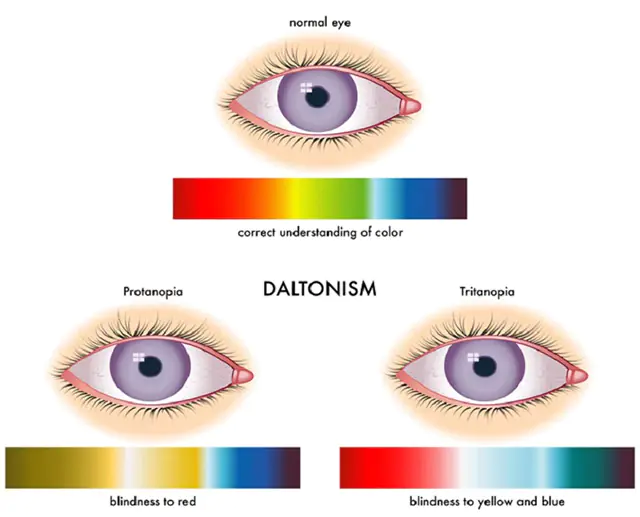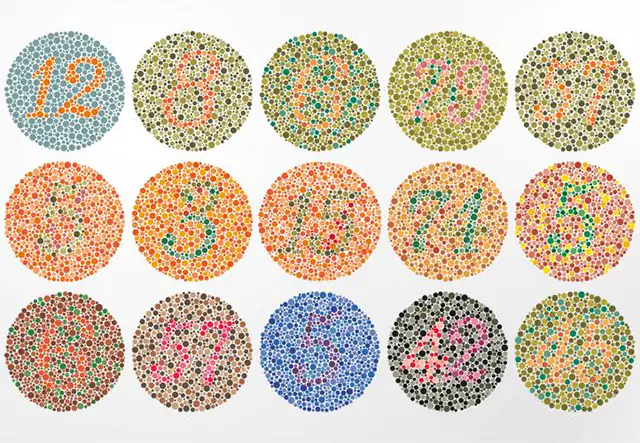
Causes of color blindness. How is the perception of colors distorted in people suffering from achromasia, monochromasia, and dichromasia? What tests do doctors use to identify colorblind people? How to treat the disease, how to prevent its occurrence?
The content of the article:- Reasons for appearance
- Types and symptoms
- Diagnostic methods
- How to treat color blindness
Color blindness is an ophthalmological disease characterized by disruption of photoreceptors. The second name for the disease is color blindness. That is, a person does not distinguish one or more shades. The congenital form of color blindness is considered incurable, but wearing special glasses and contact lenses gives a person the opportunity to change the color perception of the world.
Causes of color blindness

The eyes of a healthy person can distinguish about 7 million shades. This opportunity is provided by cones filled with protein pigments. These photoreceptors are located on the retina and only work in bright light. Violation of the proportion of components in these natural reservoirs leads to a distortion in the perception of color.
Color blindness is often hereditary. Gene transfer is associated with a mutation of the X chromosome. Therefore, in women (XX) it occurs in 0.5% of cases when both nucleoprotein elements are damaged, and in men (XY) in 5-7% of cases. Please note that the mother can be a carrier of the mutation and still distinguish colors correctly.
Color blindness is a symptom of the following genetic diseases:
- Cone dystrophy. Distorted color perception may be a symptom of a disease that affects the cone photoreceptor system. Other manifestations of the disease include decreased visual acuity and sensitivity to bright light. The pathology cannot be treated, but proper nutrition and taking eye vitamins significantly slow down its development.
- Leber's amaurosis. The cause of color blindness is damage to the light-sensitive cells of the retina. The disease is hereditary. In addition to the eyes, it affects the kidneys, thyroid gland, and central nervous system. It is impossible to cure her. Maintenance therapy consists of intraocular administration of vasodilators, vitamins, and general restoratives.
- Retinitis pigmentosa. The cause of the development of this disease is a metabolic disorder in the photoreceptors, as a result of which toxins and cellular decay products accumulate in the cones. As a result, a person’s perception of color is distorted, visibility in the peripheral zone is impaired, up to the development of “tunnel vision”. As a treatment, modern medicine can only offer supportive therapy aimed at slowing the progression of the disease.
Color blindness is also a complication of the following diseases:
- Stroke. An attack disrupts blood circulation in the brain area. Due to damage to the optic nerve, the patient experiences pain and burning in the area of the eyeball, and notes a weakening of visual acuity. Distortion of color vision is a common complication of stroke. Therefore, the sooner help was provided, the higher the likelihood of a complete cure for color blindness.
- Cataract. Clouding of the lens prevents light from reaching the photoreceptors in the eye. As a result, the entire visual system suffers. The patient ceases to distinguish colors, the image doubles, becomes distorted, and blurs. To treat cataracts, surgery is performed to remove and replace the lens. If the procedure is performed on time, the person again sees the correct color picture.
- Parkinson's disease. When nerve cells in the brain are damaged, many systems of the body suffer, including the visual one. In addition to distortion of color perception, the patient sees objects as fuzzy, blurry, and double. To improve the patient’s well-being, the doctor prescribes a separate eye treatment, which includes drops, vitamins, and special exercises.
The cause of temporary color blindness is severe poisoning by toxins. Please note that after cleansing the body, a person again distinguishes colors and shades.
Types and symptoms of color blindness

Ophthalmologists explain that colorblind people see images differently. The most complex form of light blindness is called achromasia. Its main difference is the complete absence of color pigment in the cones on the retina. Because of this, people can only distinguish shades of gray. The disease is rare (1 case in 300,000 people) and is only hereditary.
Another rare type of color blindness is monochromasia. It is characterized by the ability to see only one color and its shades. The disease is usually accompanied by photophobia (painful sensitivity of the eyes to light) and nystagmus (involuntary rhythmic eye movements).
Most often, color perception distortion manifests itself in the inability to see one color and its shades. This pathology is called dichromasia. It is divided into several subspecies:
- Protanopia- inability to see red. According to research, it is replaced by dark brown or dark green.
- Tritanopia- inability to see blue and violet images. The brain replaces them with shades of red or green.
- Deuteranopia- inability to see the color green. In this case, dark shades are perceived as orange, and light shades as yellow.
Methods for diagnosing color blindness

When colorblindness is inherited, children do not know that they see the world differently from their friends. Children repeat the names of colors after adults, memorize their shades, and answer questions correctly. At the same time, their eyes do not hurt, and their visual acuity does not decrease. Parents with the same disease, as well as teachers in fine arts classes, can suspect the presence of pathology.
Colorblindness in children is most often detected when drawing nature. Even without knowing the names of the colors, kids paint the sky and sea in blue, the grass and Christmas tree in green, and the sun in yellow. If your child constantly makes mistakes, you should consult an ophthalmologist.
There is another simple way to recognize color vision problems. Offer your child two candies (one in red and one in gray wrapper). A colorblind person hesitates before making a choice, but a healthy child will immediately reach for the bright sweetness.
Adult women and men with color blindness have difficulty obtaining a driver's license. Thus, with achromasia and monochromasia, it is prohibited to drive a vehicle. People with dichromasia can obtain a license if they undergo additional ophthalmological examination. In addition, they need to learn the rules of the road for people with distorted color perception.
If signs of color blindness are detected, you should visit an ophthalmologist. At the appointment, the specialist examines the medical history of the patient and his parents, asks about the characteristics of the symptoms, and checks visual acuity.
During the consultation, the doctor explains how to determine color blindness using tests and chooses the most effective diagnostic method:
- Rabkin tables. The patient is located at a distance of 1 meter from the doctor. The specialist shows him test pictures on which numbers and geometric shapes in the form of monochromatic circles are drawn. Moreover, the color of the background and the image are chosen in such a way that a healthy person can easily name the encrypted picture, but a sick person cannot see it.
- Ishihara test. A preliminary check for color blindness can be carried out independently on a computer monitor. The most common online test was compiled by Japanese ophthalmologist Ishihara. After clicking on the “Start” button, a multi-colored picture with an encrypted number appears on the screen. After 5 seconds the answer appears, and after that the next picture appears. If many of the drawings remain unclear to you, you need to contact an ophthalmologist.
- Falant research. This color test for color blindness is taken by people whose profession requires a quick reaction to external circumstances (military, police, sailors, pilots). During the test, subjects must quickly name what color the beacon is showing. During its course, the distance, degree of brightness, noise level, atmospheric pressure, and flicker frequency change.
- Holmgren method. For this eye test for color blindness, the doctor gives the patient 133 balls of wool of different shades. The test subject needs to sort objects into three groups (according to primary colors) over a certain period of time. In the second step, the person must arrange the skeins of each category as the brightness of the color increases. Using this test, you can determine both the disease itself and the degree of its progression.
During the tests, the patient should feel satisfactory, be sober, calm, and focused. Poor physical and psychological condition affects the speed of the brain’s reaction and devalues the result of the study. Doctors should ensure that the office is well lit and ensure that direct sunlight does not fall on the tables and does not illuminate the image.
How to treat color blindness?

Congenital color blindness cannot be treated. Therefore, parents must teach the child to live with this feature of the visual system and adapt to society.
To do this, you can use the following tips:
- Don't call color blindness a disease. Tell your child about his uniqueness and difference from others.
- Do not interrupt his speech and do not correct him every time he names the color and shade incorrectly.
- When describing objects, draw his attention to texture, size, volume and other characteristics not related to color.
- Buy your child clothes that match well in color so that the baby can dress independently and not look ridiculous.
When entering kindergarten, school and other educational institutions, it is necessary to tell teachers about the presence of color blindness. In this case, educators and teachers will be able to choose a special approach to teaching the child, which will reduce the level of anxiety and speed up the child’s adaptation to the team.
Please note that there are no medications or surgical procedures to treat color blindness. But in some cases, the intensity of symptoms can be reduced with the help of glasses and contact lenses.Glasses designed to improve color perception resemble sunglasses in appearance. Indeed, bright sunlight aggravates the manifestations of color blindness. In addition to the darkening coating, the product uses the principle of multi-layer lenses. In this case, each layer acts as a filter that allows basic colors to pass through and blocks individual shades.
Using the same principle, ophthalmic companies are developing contact lenses for colorblind people. They are made from soft hypoallergenic materials with multi-layer coating. During individual fitting, the patient puts on lenses and undergoes the Rabkin or Ishihara test. As a result, those products are left in which the result will be the highest.
Please note that glasses and contact lenses can slightly reduce the intensity of symptoms, but they cannot completely change color perception. In addition, optical instruments operate only in daylight. They are useless when watching TV or working on a computer.Acquired color blindness is treatable. To do this, it is necessary to cure the underlying disease of the body. Moreover, the sooner you start taking medications, the higher the chance of completely restoring your color perception of the world.
If color blindness or incorrect color perception is hereditary, its occurrence cannot be prevented. Parents with such a pathology should identify the disease in their child as early as possible and correct the process of his adaptation and learning.
Even during pregnancy planning, the doctor must explain to the woman how color blindness is inherited and in which cases it is impossible to prevent its occurrence. He gives recommendations on health care during conception and pregnancy.
Color blindness can develop as a complication of diseases of the eyes, circulatory system, and nervous system. Therefore, if you feel unwell, you must consult a doctor for timely detection and treatment of diseases.
What is color blindness - watch the video:



